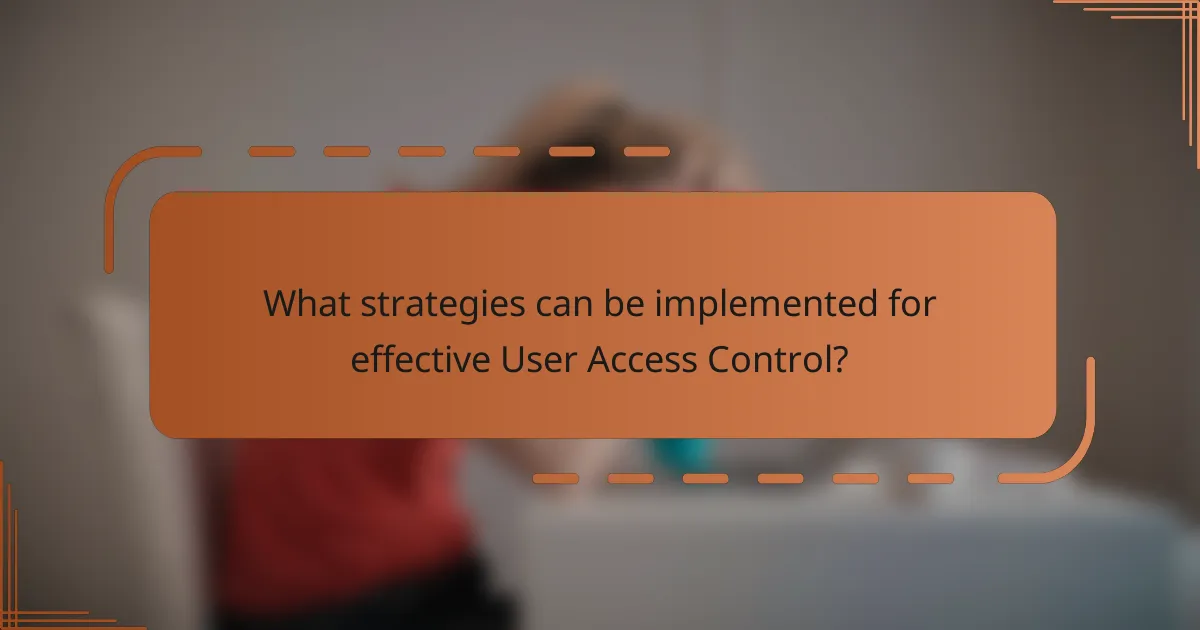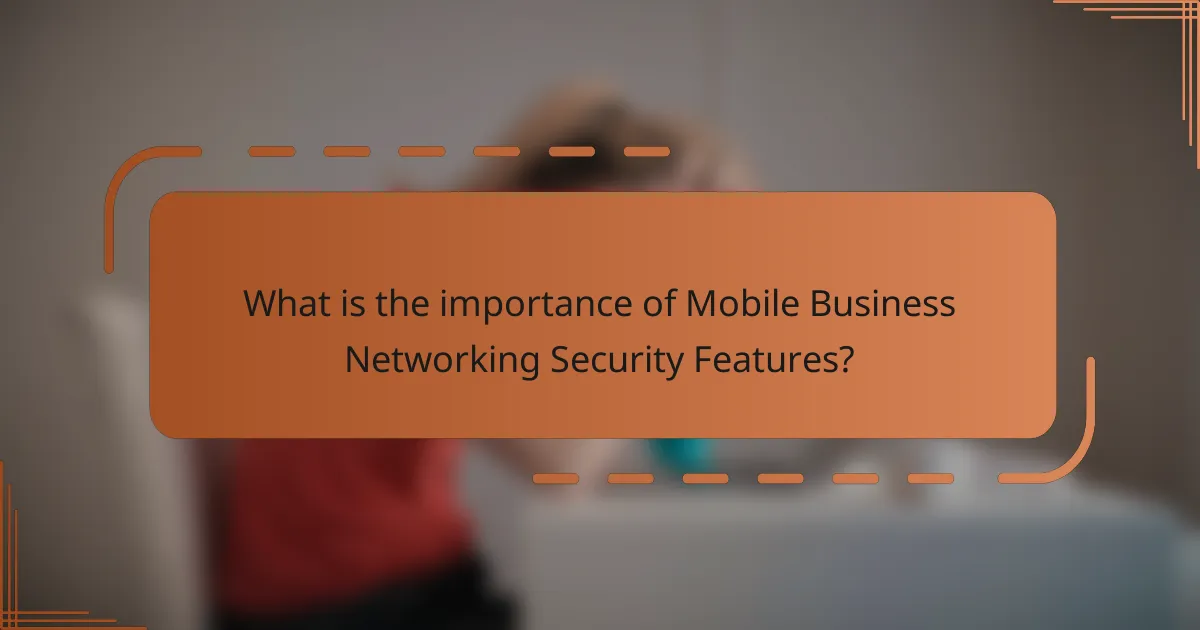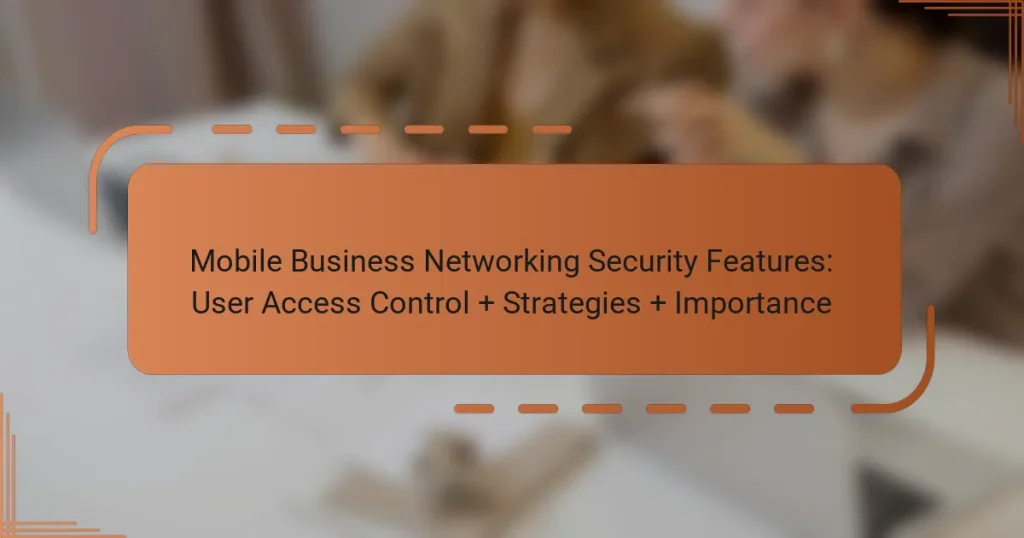Mobile business networking security features are essential for protecting sensitive data from unauthorized access and cyber threats. Key security measures include encryption, which ensures data confidentiality during transmission, authentication for verifying user identities, access control based on user roles, and threat detection to identify suspicious activities. Effective user access control strategies such as role-based access control, multi-factor authentication, regular audits, the principle of least privilege, strong password policies, and user training enhance security in mobile environments. These measures significantly reduce the risk of data breaches, protecting organizations from financial losses and fostering trust among clients and partners.

What are Mobile Business Networking Security Features?
Mobile business networking security features include encryption, authentication, access control, and threat detection. Encryption protects data during transmission, ensuring confidentiality. Authentication verifies user identities, preventing unauthorized access. Access control restricts network resources based on user roles, enhancing security. Threat detection monitors for suspicious activities, allowing for timely responses. These features collectively safeguard sensitive business information in mobile environments. Studies show that organizations implementing these security measures significantly reduce the risk of data breaches.
How do User Access Control mechanisms function in mobile networking?
User Access Control mechanisms in mobile networking function by regulating user permissions and access to network resources. They authenticate users to verify their identity before granting access. Common methods include passwords, biometrics, and tokens. Once authenticated, the system evaluates the user’s permissions based on predefined policies. These policies dictate what resources a user can access and what actions they can perform. Access Control Lists (ACLs) are often used to specify permissions for different users or groups. Additionally, role-based access control (RBAC) assigns permissions based on user roles, simplifying management. These mechanisms help protect sensitive data and ensure compliance with security policies.
What types of User Access Control exist in mobile business networking?
Types of User Access Control in mobile business networking include Role-Based Access Control (RBAC), Mandatory Access Control (MAC), Discretionary Access Control (DAC), and Attribute-Based Access Control (ABAC). RBAC assigns permissions based on user roles within the organization. MAC enforces access policies based on system classification levels. DAC allows users to control access to their own resources. ABAC grants access based on user attributes and environmental conditions. These controls help secure sensitive data and ensure that only authorized users can access specific resources.
How do User Access Control mechanisms enhance security?
User Access Control mechanisms enhance security by regulating who can access specific resources. They ensure that only authorized users can view or modify sensitive information. This limitation reduces the risk of data breaches and unauthorized access. By implementing role-based access control, organizations can assign permissions based on user roles. This method minimizes the potential for human error and misuse of data. Continuous monitoring of access logs further strengthens security by identifying suspicious activities. According to a study by the Ponemon Institute, organizations with strong access controls experience 50% fewer data breaches. Thus, effective User Access Control mechanisms are essential for maintaining robust security in mobile business networking.
Why are security features critical for mobile business networking?
Security features are critical for mobile business networking to protect sensitive data and ensure secure communication. Mobile devices are often vulnerable to cyber threats, including hacking and data breaches. According to a report by Verizon, 43% of data breaches involve small businesses, highlighting the need for robust security measures. These features help in authenticating users and controlling access to sensitive information. Encryption is essential for safeguarding data transmitted over mobile networks. Implementing security protocols can reduce the risk of unauthorized access and ensure compliance with regulations. Overall, effective security features are vital for maintaining trust and integrity in mobile business networking.
What risks are associated with inadequate security in mobile business networking?
Inadequate security in mobile business networking poses significant risks. These risks include data breaches, which can expose sensitive information to unauthorized users. Malware attacks can compromise mobile devices, leading to loss of data integrity. Additionally, inadequate security can result in identity theft, where attackers impersonate legitimate users. Compliance violations may occur if organizations fail to protect data as required by regulations. Furthermore, financial losses can arise from recovery efforts and reputational damage. According to a 2021 report by IBM, the average cost of a data breach is $4.24 million.
How can security features mitigate these risks?
Security features can mitigate risks by implementing robust user access control mechanisms. These mechanisms ensure that only authorized users can access sensitive information. Multi-factor authentication adds an additional layer of security, making unauthorized access more difficult. Encryption protects data in transit and at rest, reducing the risk of data breaches. Regular software updates and patches address vulnerabilities that could be exploited by attackers. Intrusion detection systems monitor network traffic for suspicious activity, enabling quick responses to potential threats. According to a 2021 Cybersecurity report, organizations that implemented comprehensive security features experienced a 60% reduction in security incidents.

What strategies can be implemented for effective User Access Control?
Implementing effective user access control requires several strategies. First, role-based access control (RBAC) assigns permissions based on user roles. This limits access to necessary resources, enhancing security. Second, implementing multi-factor authentication (MFA) adds an extra layer of protection. MFA requires users to provide multiple forms of verification, reducing unauthorized access risks.
Third, regular audits and reviews of access permissions ensure that only authorized users maintain access. This helps identify and remove unnecessary permissions. Fourth, utilizing the principle of least privilege (PoLP) restricts user access to the minimum necessary for their job functions. This minimizes potential exposure to sensitive data.
Fifth, employing strong password policies enforces complexity and regular updates. Strong passwords are essential for protecting user accounts. Lastly, user training and awareness programs educate employees on security best practices. This fosters a culture of security within the organization.
These strategies collectively enhance user access control, safeguarding sensitive information in mobile business networking environments.
How can organizations implement role-based access control?
Organizations can implement role-based access control (RBAC) by defining user roles and assigning permissions accordingly. First, they should identify the various roles within the organization, such as admin, user, and guest. Each role must have specific permissions that align with job functions. Next, organizations should create a centralized access control policy that dictates these roles and permissions. This policy should be documented and communicated to all staff members.
Organizations can utilize software tools to manage and enforce RBAC policies effectively. These tools can automate permission assignments and ensure compliance with the access control policy. Regular audits should be conducted to review role assignments and permissions. This helps to identify any discrepancies or necessary changes in access rights.
Implementing RBAC not only enhances security by limiting access to sensitive information but also simplifies user management. According to a study by the National Institute of Standards and Technology (NIST), effective access control mechanisms, including RBAC, significantly reduce the risk of unauthorized access.
What are the benefits of role-based access control in mobile networking?
Role-based access control (RBAC) enhances security in mobile networking by restricting access based on user roles. This ensures that users can only access resources necessary for their job functions. RBAC simplifies management by allowing administrators to assign permissions to roles rather than individual users. This reduces the risk of unauthorized access and data breaches. Additionally, it provides a clear audit trail, making it easier to track user activities. Organizations can enforce compliance with regulations by ensuring only authorized personnel access sensitive information. Overall, RBAC improves operational efficiency and enhances security in mobile networking environments.
How does role-based access control improve user experience?
Role-based access control (RBAC) improves user experience by providing tailored access to resources based on user roles. This customization allows users to access only the information and tools relevant to their job functions. As a result, users encounter less clutter and distraction, enabling them to focus on their tasks efficiently. Additionally, RBAC enhances security by minimizing the risk of unauthorized access, which builds user trust in the system. A study by the National Institute of Standards and Technology found that implementing RBAC can reduce the time spent on access management by up to 50%. This efficiency contributes to a smoother user experience in mobile business networking environments.
What best practices should be followed for User Access Control?
Implementing best practices for User Access Control enhances security and protects sensitive data. First, apply the principle of least privilege. This limits user access to only what is necessary for their role. Second, enforce strong password policies. Require complex passwords and regular updates to enhance security. Third, implement multi-factor authentication (MFA). MFA adds an extra layer of security beyond just passwords. Fourth, regularly review and update access permissions. This ensures that only current employees retain access. Fifth, log and monitor access activities. This helps detect unauthorized access attempts. Lastly, provide user training on security practices. Educated users are less likely to fall victim to attacks. Following these practices significantly reduces the risk of data breaches and unauthorized access.
How can regular audits enhance User Access Control effectiveness?
Regular audits enhance User Access Control effectiveness by identifying vulnerabilities and ensuring compliance. They provide a systematic review of access permissions and user activities. Regular audits help detect unauthorized access attempts. They also ensure that users have appropriate access based on their roles. By analyzing audit logs, organizations can identify patterns of misuse or anomalies. This proactive approach allows for timely adjustments to access controls. Studies show that organizations with regular audits experience fewer security breaches. Implementing audits can lead to improved overall security posture and user accountability.
What training is necessary for employees regarding User Access Control?
Employees must receive training on the principles of User Access Control. This training should cover the importance of safeguarding sensitive information. Employees need to understand role-based access permissions. They should learn how to create strong passwords and the significance of password management. Training must include recognizing phishing attempts and social engineering tactics. Employees should also be educated on the process of reporting security incidents. Regular refresher courses are essential to keep knowledge current. Compliance with organizational policies and regulations should be emphasized throughout the training.

What is the importance of Mobile Business Networking Security Features?
Mobile business networking security features are crucial for protecting sensitive data. They help prevent unauthorized access to business networks. Security features like encryption and multi-factor authentication safeguard information during transmission. According to a report by Cybersecurity Ventures, cybercrime is projected to cost the world $10.5 trillion annually by 2025. Implementing robust security features reduces the risk of data breaches. This can save companies from significant financial losses and reputational damage. Additionally, secure mobile networking fosters trust among clients and partners. Trust is essential for maintaining long-term business relationships.
How do security features impact overall business operations?
Security features significantly enhance overall business operations by protecting sensitive data and ensuring compliance. They prevent unauthorized access to information and systems, reducing the risk of data breaches. According to a 2020 report by IBM, the average cost of a data breach is $3.86 million. Implementing robust security features can mitigate these costs. Furthermore, effective security measures foster customer trust. A survey by PwC found that 85% of consumers will not do business with a company if they have concerns about its security practices. Overall, security features streamline operations by minimizing risks and enhancing stakeholder confidence.
What are the long-term benefits of investing in security features?
Investing in security features provides long-term benefits such as enhanced data protection and reduced risk of breaches. Businesses experience fewer security incidents over time, which saves costs associated with recovery and legal fees. Strong security measures build customer trust, leading to increased customer loyalty and retention. Additionally, compliance with regulations is maintained, avoiding fines and penalties. Companies with robust security features often see improved operational efficiency due to streamlined processes. A secure environment fosters innovation, allowing businesses to explore new technologies without fear. According to a report by Cybersecurity Ventures, global cybercrime damages are projected to reach $10.5 trillion annually by 2025, emphasizing the importance of proactive security investments.
How do security features contribute to customer trust and loyalty?
Security features enhance customer trust and loyalty by ensuring data protection and privacy. When customers feel their information is secure, they are more likely to engage with a business. Strong security measures, such as encryption and multi-factor authentication, demonstrate a commitment to safeguarding user data. According to a study by PwC, 79% of consumers are concerned about sharing personal information online. Businesses that prioritize security can build a positive reputation and foster long-term relationships. Trust is often linked to perceived reliability, and robust security features contribute significantly to this perception. In a competitive market, companies that effectively communicate their security protocols can differentiate themselves and attract loyal customers.
What common challenges do businesses face in implementing security features?
Businesses commonly face several challenges in implementing security features. One significant challenge is the lack of adequate budget allocation for security measures. According to a 2022 report by Cybersecurity Ventures, global spending on cybersecurity is expected to exceed $1 trillion from 2017 to 2021, indicating the financial demands involved.
Another challenge is the complexity of integrating new security technologies with existing systems. Many businesses operate on legacy systems that may not support modern security solutions. Additionally, there is often a shortage of skilled cybersecurity professionals. The International Information System Security Certification Consortium (ISC)² reported a global cybersecurity workforce gap of 3.4 million professionals in 2021.
User resistance to new security protocols also poses a challenge. Employees may find new security measures inconvenient, leading to non-compliance. Furthermore, businesses must navigate regulatory compliance issues, which can vary by region and industry. The General Data Protection Regulation (GDPR) imposes strict data protection requirements that can complicate security feature implementation.
Finally, the evolving threat landscape requires continuous updates and adaptations to security measures. Cyber threats are becoming more sophisticated, necessitating ongoing training and awareness programs for employees. These challenges collectively hinder effective security feature implementation in businesses.
How can businesses overcome these challenges effectively?
Businesses can overcome mobile networking security challenges by implementing robust user access control measures. These measures include multi-factor authentication, which significantly reduces unauthorized access. Regularly updating security protocols is essential to address emerging threats. Employee training on security best practices enhances awareness and reduces human error. Utilizing encryption for data transmission protects sensitive information during transfer. Monitoring and auditing access logs help identify suspicious activities promptly. Adopting a zero-trust security model ensures that no user is trusted by default. Research shows that organizations with comprehensive security strategies experience fewer breaches and improved compliance.
What practical tips can enhance Mobile Business Networking Security Features?
Implementing strong passwords is essential for enhancing mobile business networking security features. Passwords should be complex, combining letters, numbers, and special characters. Regularly updating these passwords adds an extra layer of protection. Utilizing two-factor authentication (2FA) significantly reduces the risk of unauthorized access. This method requires a second form of verification, such as a text message code.
Employing a Virtual Private Network (VPN) encrypts data transmitted over public networks. This is crucial when accessing sensitive information remotely. Keeping mobile devices updated with the latest security patches protects against vulnerabilities. Regular software updates ensure that security features are current and effective.
Educating employees about phishing attacks is vital. Awareness training can help them identify suspicious emails or links. Additionally, limiting user access to sensitive information minimizes potential risks. Only authorized personnel should have access to critical data. Monitoring network activity for unusual behavior can also help detect potential threats early.
Mobile Business Networking Security Features encompass critical components such as user access control, encryption, authentication, and threat detection, all aimed at protecting sensitive data in mobile environments. The article details various user access control mechanisms, including Role-Based Access Control (RBAC) and Multi-Factor Authentication (MFA), which enhance security by regulating user permissions and access to resources. Additionally, it discusses the importance of implementing robust security features to mitigate risks like data breaches and compliance violations, while also providing strategies for effective user access control and the long-term benefits of investing in security measures. Overall, the content outlines the significance of these security features in maintaining data integrity, fostering customer trust, and ensuring organizational compliance in mobile business networking.


